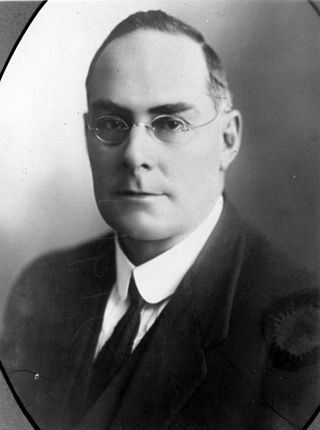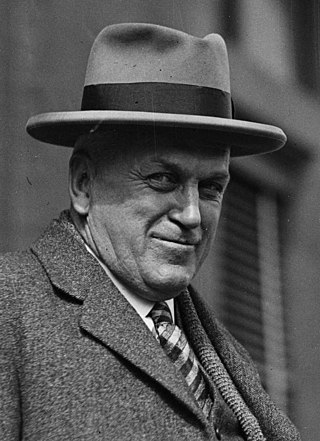Related Research Articles

William McCormack was Premier of Queensland, Australia, from 1925 to 1929.

The Shire of Dalrymple was a local government area located in North Queensland, Australia, and surrounded but did not include the town of Charters Towers, at which its council and administrative centre was based. It covered an area of 68,324.5 square kilometres (26,380.2 sq mi), and existed as a local government entity from 1879 until 2008, when it amalgamated with the separate City of Charters Towers to form the Charters Towers Region.
This is a list of members of the 23rd Legislative Assembly of Queensland from 1923 to 1926, as elected at the 1923 state election held on 12 May 1923.
The Moore Ministry was a ministry of the Government of Queensland and was led by Country and Progressive National Party (CPNP) Premier Arthur Edward Moore. It succeeded the McCormack Ministry on 21 May 1929, ten days after William McCormack's Labor government was defeated at the 1929 state election. The ministry was followed by the Forgan Smith Ministry on 18 June 1932 after the CPNP were defeated by Labor at the 1932 state election a week earlier.

Elections were held in the Australian state of Queensland on 11 June 1932 to elect the 62 members of the state's Legislative Assembly.
The Forgan Smith Ministry was a ministry of the Government of Queensland and was led by Labor Premier William Forgan Smith. It succeeded the Moore Ministry on 18 June 1932, seven days after Arthur Edward Moore's CPNP government was defeated at the 1932 state election. The ministry was followed by the Cooper Ministry on 16 September 1942 following Forgan Smith's retirement from politics.
The Cooper Ministry was a ministry of the Government of Queensland and was led by Labor Premier Frank Cooper. It succeeded the Forgan Smith Ministry on 16 September 1942 following Forgan Smith's resignation from the Ministry after over 10 years as Premier. The ministry was followed by the Hanlon Ministry on 7 March 1946 following Cooper's own resignation.
The Hanlon Ministry was a ministry of the Government of Queensland and was led by Labor Premier Ned Hanlon. It succeeded the Cooper Ministry on 7 March 1946 following Frank Cooper's resignation from the Ministry. The ministry was followed by the Gair Ministry on 17 January 1952 following Hanlon's death in office two days earlier.

Elections were held in the Australian state of Queensland on 29 April 1950 to elect the 75 members of the state's Legislative Assembly. The Labor government was seeking its seventh continuous term in office since the 1932 election; it would be Premier Ned Hanlon's second election.

Elections were held in the Australian state of Queensland on 11 May 1929 to elect the 72 members of the state's Legislative Assembly. In this election, Irene Longman became the first woman to both stand and be elected into the Queensland Parliament.
The Denham Ministry was the 26th ministry of the Government of Queensland and was led by Premier Digby Denham, who led the Ministerialist party consisting of a mixture of liberals and conservatives. It succeeded the Kidston Ministry on 7 February 1911. The ministry was followed by the Ryan Ministry on 1 June 1915 after the government was defeated by the Labor Party at the 1915 state election on 22 May, at which several of the ministers including Denham himself lost their seats.

The Gair Ministry was a ministry of the Government of Queensland and was led by Labor Premier Vince Gair. It succeeded the Hanlon Ministry on 17 January 1952 following Ned Hanlon's death two days earlier. On 26 April 1957, Gair and most of the Ministry were expelled from the Labor Party and formed the Queensland Labor Party (QLP), retaining the ministry but losing the confidence of the Assembly. The ministry was followed by the Nicklin Ministry on 12 August 1957 following the defeat of both Labor and the QLP at the resulting election.
The Second Kidston Ministry was the 25th ministry of the Government of Queensland and was led by Premier William Kidston. It succeeded the Second Philp Ministry on 18 February 1908, 13 days after the 1908 state election. The ministry was followed by the Denham Ministry on 7 February 1911 following Kidston's retirement from politics.
The Ryan Ministry was the 27th ministry of the Government of Queensland and was led by Premier T. J. Ryan of the Labor Party. It was the first majority Labor government in Queensland's history. It succeeded the Denham Ministry on 1 June 1915, following the latter's defeat at the 1915 state election on 22 May. It was succeeded by the Theodore Ministry on 22 October 1919 following T. J. Ryan's resignation from the Queensland parliament to run for federal politics.
The Theodore Ministry was the 28th ministry of the Government of Queensland and was led by Premier Ted Theodore of the Labor Party. It succeeded the Ryan Ministry on 22 October 1919 following T. J. Ryan's resignation from the Queensland parliament to run for federal politics, and was in turn succeeded by the Gillies Ministry on 26 February 1925 when Theodore followed his predecessor into federal politics.
The Gillies Ministry was the 29th ministry of the Government of Queensland and was led by Premier William Gillies of the Labor Party. It succeeded the Theodore Ministry on 26 February 1925 following Ted Theodore's resignation, and was in turn succeeded by the McCormack Ministry on 22 October 1925 when Gillies resigned to become a member of the new trade and arbitration board.

Elections were held in the Australian state of Queensland on 8 May 1926 to elect the 72 members of the state's Legislative Assembly. The Labor government was seeking its fifth continuous term in office since the 1915 election. William McCormack was contesting his first election as Premier.

Elections were held in the Australian state of Queensland on 27 May 1972 to elect the 82 members of the Legislative Assembly of Queensland.

David Alexander Gledson was an accountant and member of the Queensland Legislative Assembly.
The Bjelke-Petersen Ministry was a ministry of the Government of Queensland and was led by Premier Joh Bjelke-Petersen, who led the Country Party and its successor, the National Party. It succeeded the Chalk Ministry on 8 August 1968 as part of a series of events following the death of former Premier Jack Pizzey on 31 July. It was succeeded by the Ahern Ministry on 1 December 1987 following Bjelke-Petersen's resignation as Premier.
References
- "Proclamation". Queensland Government Gazette . 22 October 1925. p. 125:1619–1620.
- "Proclamation". Queensland Government Gazette . 21 May 1929. p. 132:1361.
- Parliament of Queensland (2009). Alphabetical Register of Members of the Legislative Assembly 1860-2009 (PDF). Archived from the original (PDF) on 15 June 2009. Retrieved 10 December 2009.